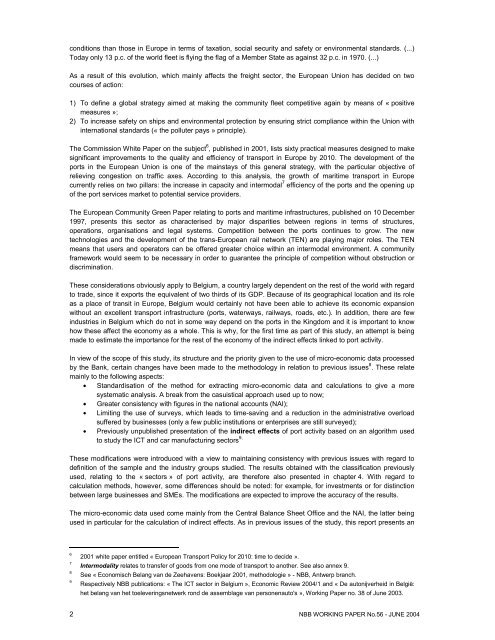Economic importance of the Flemish maritime ports: Report 2002
Economic importance of the Flemish maritime ports: Report 2002
Economic importance of the Flemish maritime ports: Report 2002
Create successful ePaper yourself
Turn your PDF publications into a flip-book with our unique Google optimized e-Paper software.
conditions than those in Europe in terms <strong>of</strong> taxation, social security and safety or environmental standards. (...)Today only 13 p.c. <strong>of</strong> <strong>the</strong> world fleet is flying <strong>the</strong> flag <strong>of</strong> a Member State as against 32 p.c. in 1970. (...)As a result <strong>of</strong> this evolution, which mainly affects <strong>the</strong> freight sector, <strong>the</strong> European Union has decided on twocourses <strong>of</strong> action:1) To define a global strategy aimed at making <strong>the</strong> community fleet competitive again by means <strong>of</strong> « positivemeasures »;2) To increase safety on ships and environmental protection by ensuring strict compliance within <strong>the</strong> Union withinternational standards (« <strong>the</strong> polluter pays » principle).The Commission White Paper on <strong>the</strong> subject 6 , published in 2001, lists sixty practical measures designed to makesignificant improvements to <strong>the</strong> quality and efficiency <strong>of</strong> transport in Europe by 2010. The development <strong>of</strong> <strong>the</strong><strong>ports</strong> in <strong>the</strong> European Union is one <strong>of</strong> <strong>the</strong> mainstays <strong>of</strong> this general strategy, with <strong>the</strong> particular objective <strong>of</strong>relieving congestion on traffic axes. According to this analysis, <strong>the</strong> growth <strong>of</strong> <strong>maritime</strong> transport in Europecurrently relies on two pillars: <strong>the</strong> increase in capacity and intermodal 7 efficiency <strong>of</strong> <strong>the</strong> <strong>ports</strong> and <strong>the</strong> opening up<strong>of</strong> <strong>the</strong> port services market to potential service providers.The European Community Green Paper relating to <strong>ports</strong> and <strong>maritime</strong> infrastructures, published on 10 December1997, presents this sector as characterised by major disparities between regions in terms <strong>of</strong> structures,operations, organisations and legal systems. Competition between <strong>the</strong> <strong>ports</strong> continues to grow. The newtechnologies and <strong>the</strong> development <strong>of</strong> <strong>the</strong> trans-European rail network (TEN) are playing major roles. The TENmeans that users and operators can be <strong>of</strong>fered greater choice within an intermodal environment. A communityframework would seem to be necessary in order to guarantee <strong>the</strong> principle <strong>of</strong> competition without obstruction ordiscrimination.These considerations obviously apply to Belgium, a country largely dependent on <strong>the</strong> rest <strong>of</strong> <strong>the</strong> world with regardto trade, since it ex<strong>ports</strong> <strong>the</strong> equivalent <strong>of</strong> two thirds <strong>of</strong> its GDP. Because <strong>of</strong> its geographical location and its roleas a place <strong>of</strong> transit in Europe, Belgium would certainly not have been able to achieve its economic expansionwithout an excellent transport infrastructure (<strong>ports</strong>, waterways, railways, roads, etc.). In addition, <strong>the</strong>re are fewindustries in Belgium which do not in some way depend on <strong>the</strong> <strong>ports</strong> in <strong>the</strong> Kingdom and it is important to knowhow <strong>the</strong>se affect <strong>the</strong> economy as a whole. This is why, for <strong>the</strong> first time as part <strong>of</strong> this study, an attempt is beingmade to estimate <strong>the</strong> <strong>importance</strong> for <strong>the</strong> rest <strong>of</strong> <strong>the</strong> economy <strong>of</strong> <strong>the</strong> indirect effects linked to port activity.In view <strong>of</strong> <strong>the</strong> scope <strong>of</strong> this study, its structure and <strong>the</strong> priority given to <strong>the</strong> use <strong>of</strong> micro-economic data processedby <strong>the</strong> Bank, certain changes have been made to <strong>the</strong> methodology in relation to previous issues 8 . These relatemainly to <strong>the</strong> following aspects:• Standardisation <strong>of</strong> <strong>the</strong> method for extracting micro-economic data and calculations to give a moresystematic analysis. A break from <strong>the</strong> casuistical approach used up to now;• Greater consistency with figures in <strong>the</strong> national accounts (NAI);• Limiting <strong>the</strong> use <strong>of</strong> surveys, which leads to time-saving and a reduction in <strong>the</strong> administrative overloadsuffered by businesses (only a few public institutions or enterprises are still surveyed);• Previously unpublished presentation <strong>of</strong> <strong>the</strong> indirect effects <strong>of</strong> port activity based on an algorithm usedto study <strong>the</strong> ICT and car manufacturing sectors 9,These modifications were introduced with a view to maintaining consistency with previous issues with regard todefinition <strong>of</strong> <strong>the</strong> sample and <strong>the</strong> industry groups studied. The results obtained with <strong>the</strong> classification previouslyused, relating to <strong>the</strong> « sectors » <strong>of</strong> port activity, are <strong>the</strong>refore also presented in chapter 4. With regard tocalculation methods, however, some differences should be noted: for example, for investments or for distinctionbetween large businesses and SMEs. The modifications are expected to improve <strong>the</strong> accuracy <strong>of</strong> <strong>the</strong> results.The micro-economic data used come mainly from <strong>the</strong> Central Balance Sheet Office and <strong>the</strong> NAI, <strong>the</strong> latter beingused in particular for <strong>the</strong> calculation <strong>of</strong> indirect effects. As in previous issues <strong>of</strong> <strong>the</strong> study, this report presents an67892001 white paper entitled « European Transport Policy for 2010: time to decide ».Intermodality relates to transfer <strong>of</strong> goods from one mode <strong>of</strong> transport to ano<strong>the</strong>r. See also annex 9.See « Economisch Belang van de Zeehavens: Boekjaar 2001, methodologie » - NBB, Antwerp branch.Respectively NBB publications: « The ICT sector in Belgium », <strong>Economic</strong> Review 2004/1 and « De autonijverheid in België:het belang van het toeleveringsnetwerk rond de assemblage van personenauto's », Working Paper no. 38 <strong>of</strong> June 2003.2 NBB WORKING PAPER No.56 - JUNE 2004
















